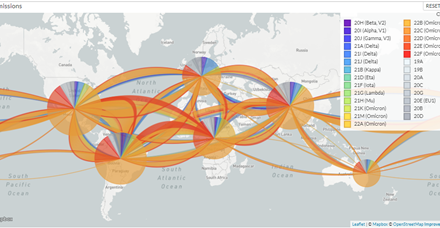Statement of the Independent Allocation of Vaccines Group (IAVG) of COVAX
The IAVG is concerned that the primary priority use of available vaccines is not consistent with the goals outlined in the Strategy to Achieve Global COVID-19 Vaccination by Mid-2022 in October 2021. [2] The group also notes that it has validated the allocation of only 730 million of the estimated 8 billion doses of vaccine that have been administered globally, which is less than 10%. The rapid emergence of the Omicron variant is a stark reminder of the ongoing threat posed by the evolution of the COVID-19 pandemic and reinforces the critical need to achieve high levels of immunization coverage in all countries, including in highly vulnerable populations, in a timely manner.
The IAVG is therefore calling for:
Achievement of 70% coverage with COVID-19 vaccines in all countries as a global imperative.
As the overall vaccine supply to COVAX is anticipated to continue to grow substantially next year, COVAX will have a greater opportunity to contribute to achieving this goal. Manufacturers, vaccine-producing and high-coverage countries must prioritize vaccine equity and transparency, including the sharing of information about manufacturing capacity and supply schedules with COVAX, as well as vaccine access plans.
All countries to work with COVAX with considerable urgency to optimize the strategic use of the growing vaccine supply.
This means that high-coverage countries will need to establish complementary, “dual-track” approaches that consider both domestic and international goals.
Greater attention must be paid to who is being immunized. Equity must remain the overarching principle, and priority must be given in all countries to ensuring that the primary series is offered first and foremost to all adults and adolescents, in the step-wise manner recommended by the WHO, given that a high proportion of these populations still require primary immunization. However, as more is known about the required vaccination response in the face of Omicron, the need for booster doses and need to immunize children, the COVAX vaccine allocation decisions must consider these recommendations.
Given the global health and epidemiologic consequences of failing to immunize vulnerable populations, including those in humanitarian settings, the IAVG recommends that COVAX continue to work with all manufacturers and countries to immediately increase the availability and uptake of vaccines in these populations.
All countries to have a steady, predictable supply of COVID-19 vaccines, which meet the unique needs of each country. Attention must be paid to addressing prohibitive absorptive challenges in countries that request support.
This may include support for vaccine storage, distribution, administration and/or record-keeping, which may in part be due to competing health and immunization crises [3]. It will be important to have close collaboration between all COVAX partners, donors, and participants.
In order to increase demand for COVID-19 vaccines, ongoing, concerted global, national and local leadership is required to address vaccine misinformation.
Background
The initial COVAX targets were to achieve 3% coverage and then 20% vaccine coverage through COVAX-secured doses by the end of 2021. [4] These targets were then expanded globally, when WHO released the Strategy to Achieve Global COVID-19 Vaccination by Mid-2022 in October 2021. [5] The new global target is 40% total population coverage by the end of 2021, and 70% total population coverage by mid-2022. However, these figures were from all country sources of supply, not solely from COVAX. COVAX would nonetheless contribute as much as possible to efforts to reach this coverage level in a fair and equitable manner.
None of these targets have been met. Ninety-eight countries have not vaccinated 40% of their population. An estimated 1.4 billion eligible people [6] need to be urgently immunized, many of whom are in the highest risk groups for death and serious illness. These gaps have been most pronounced in low-and lower-middle-income countries (LICs and LMICs), with 34 out of 89 Advanced Market Commitment (AMC) participants,[7] representing the countries that are most dependent on COVAX to access COVID-19 vaccines, not achieving the 40% target. The main reason for this has been the severe vaccine supply constraints to COVAX, which persisted until the last quarter of 2021. In the forthcoming months, larger volumes of vaccines are expected to become available, but in most cases, the increase in volumes will create challenges in absorption capacity in resource-poor settings. This includes the capacity to receive, store, distribute, administer (due, for example, the lack of trained health personnel or vaccination centers), and to record vaccine use, including wastage.
Another hurdle in achieving the target of 70% total population coverage in all countries by mid-2022 will be demand limits arising from widespread misinformation and its resulting vaccine hesitancy.
Challenges
The COVAX portion of the global supply – The original goal of COVAX was to achieve fair and equitable vaccine access across all 162 current Facility participants, and the initial role of the IAVG was to validate vaccine allocation decisions (VAD) proposals that included all participants. Many high-income countries (HICs) entered into direct contractual arrangements with vaccine suppliers, bypassing the COVAX mechanism, and pharmaceutical companies did not prioritize and deliver according to their contractual obligations with COVAX, seriously reducing its supply and making it highly unpredictable. Moreover, high-coverage countries began donating directly to their low-coverage and low-income counterparts, bypassing COVAX. Indemnity and liability-related conditions are added barriers to vaccine access for the most vulnerable populations. The IAVG has validated the allocation of only 730 million of the estimated 8 billion doses of vaccine that have been administered globally, which is less than 10%.
Additionally, many of the donated doses channeled through COVAX have been earmarked for specific countries, compounding the challenge of achieving the goal of fair and equitable access among lower-income countries.
With respect to vaccine allocation, the IAVG recommended and acknowledges that, where feasible, the limited COVAX supply has recently been dedicated to those countries with low estimated total population coverage which are likely relying solely on COVAX for access to COVID-19 vaccines.
Unpredictable supply to COVAX – 1) Procured doses – While those involved in vaccine allocation through COVAX have done their best to direct and redirect available doses, supply unpredictability has strained the system, frustrated participating countries and undermined the allocation decisions of the IAVG. Not all expected doses from COVAX advanced purchase agreements (APAs) have been honoured by vaccine producers according to contractual obligations. 2) Donated volumes – Similarly, promised donations by high-income countries have often been late to materialize or unpredictable. Unexpected additional vaccine allocation rounds have been undertaken after sudden announcements of vaccine availability through donations to COVAX. Worsening the challenge, these sudden donations have often included vaccines with brief expiry windows. These last-minute scrambles, a part massively increasing transaction costs, added considerable stress to already severely resource-strapped countries coping with many competing health and humanitarian crises, straining participants’ ability to plan for the receipt and use of their allocated vaccines. Beyond logistics, the last-minute deliveries undermined countries’ efforts to inform the general public about the vaccines and the communication needed to counteract the misinformation spread by social media.
This way of doing business is not acceptable and needs to end.
Across country and in-country inequity – The Global COVID-19 Vaccination Strategy [8] clearly outlines the step-by-step process needed to achieve the immediate goal of minimizing deaths, severe disease and overall disease burden, and reducing the risk of new variants. Older adults and high-risk populations, all adults, and adolescents have been prioritized in a step-wise manner, while the broader scope of vaccine-use recommendations is still under consideration. For instance, 15 times [9] as many booster doses are currently being administered globally as are primary doses in LICs. In October, the WHO and many other concerned partners [10] noted that data from 119 countries suggest that by September 2021, two in five health and care workers (HCW) were vaccinated on average. But the differences across regions and economic groups remained stark. For instance, less than one in ten have been fully vaccinated in the African region while four in five have been vaccinated in 22 mostly high income countries.
The IAVG is concerned that the primary priority use of available vaccines is not consistent with the goals outlined the Strategy.
More supply but more unknowns – Although the world is expected to have enough COVID-19 vaccine doses by mid-2022 to vaccinate 70% of the world’s population with three doses, [11] uncertainties abound. These include the possible need for variant-specific vaccines, changes to vaccination policies, country preference for some products over others, the programmatic complexity of managing multiple products, and the need for better intelligence on country-level planning and execution.
The uncertainty of the required vaccination response to the Omicron variant will necessitate ongoing attention to achieving fairness and equity while requiring flexibility in vaccine allocation and supply management.
Highly vulnerable populations – Our collective health security depends on the health security of all populations wherever they are, and whatever status they may have in individual countries. Among them, people residing in humanitarian settings (refugees, internally displaced persons) are at considerably increased risk of infection with COVID-19 [12] and should be covered by country vaccine allocations.












